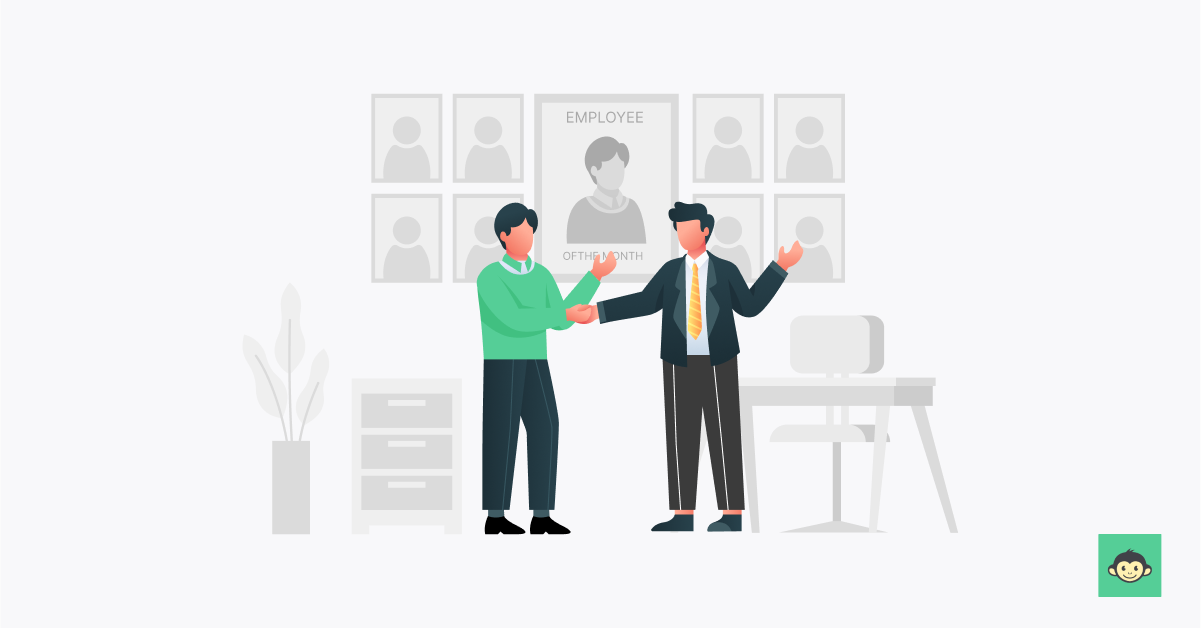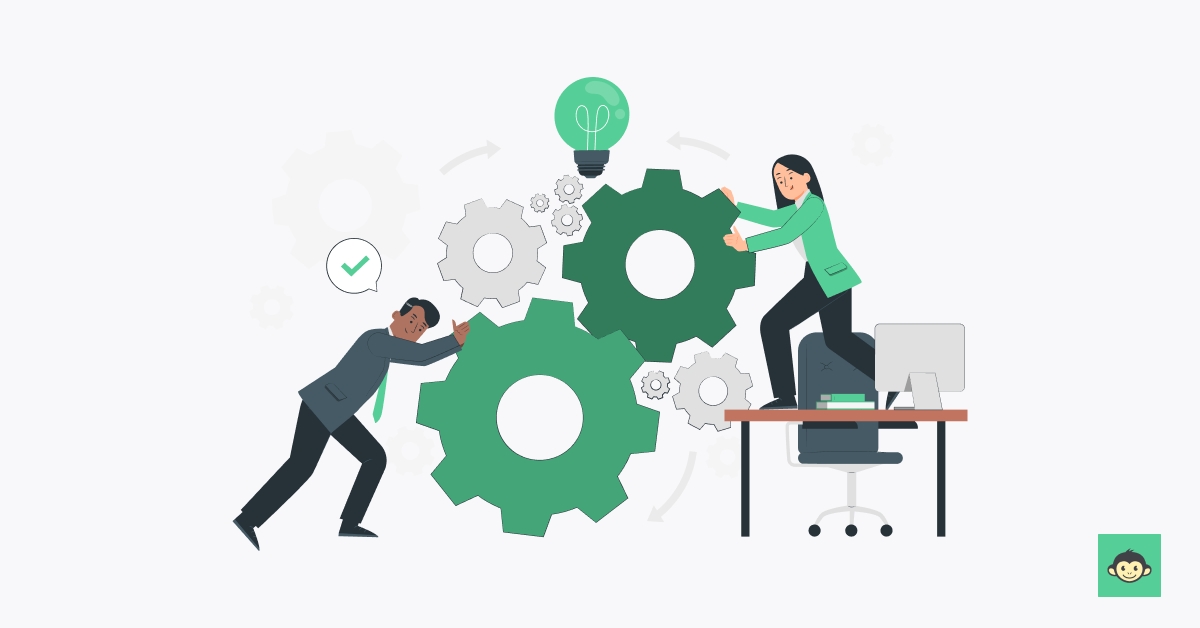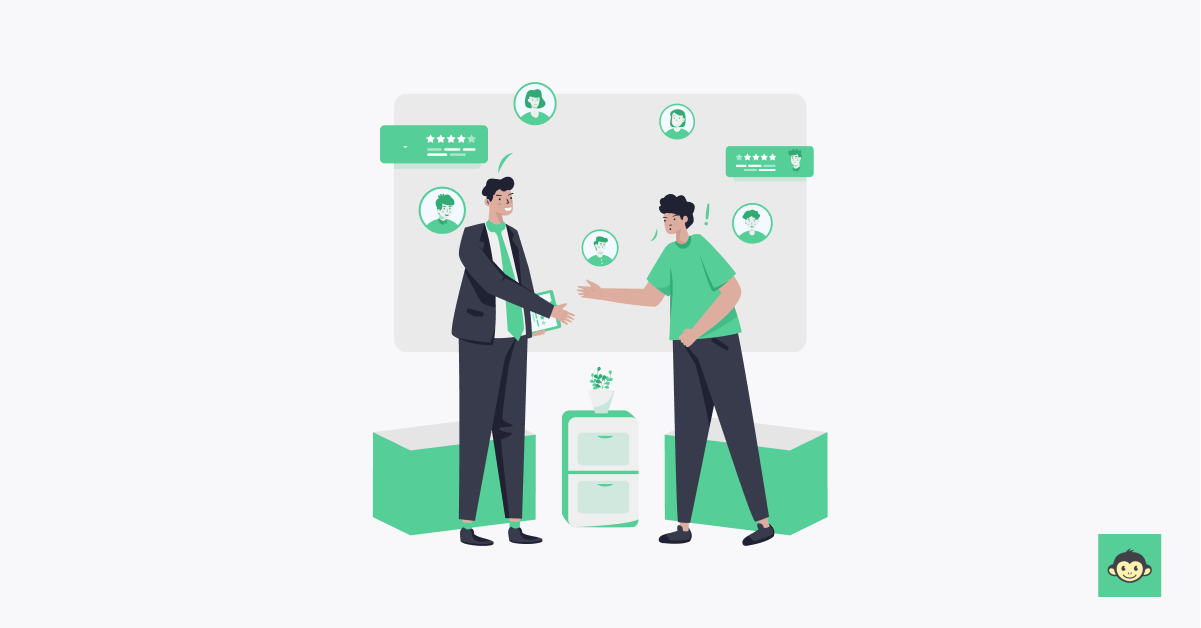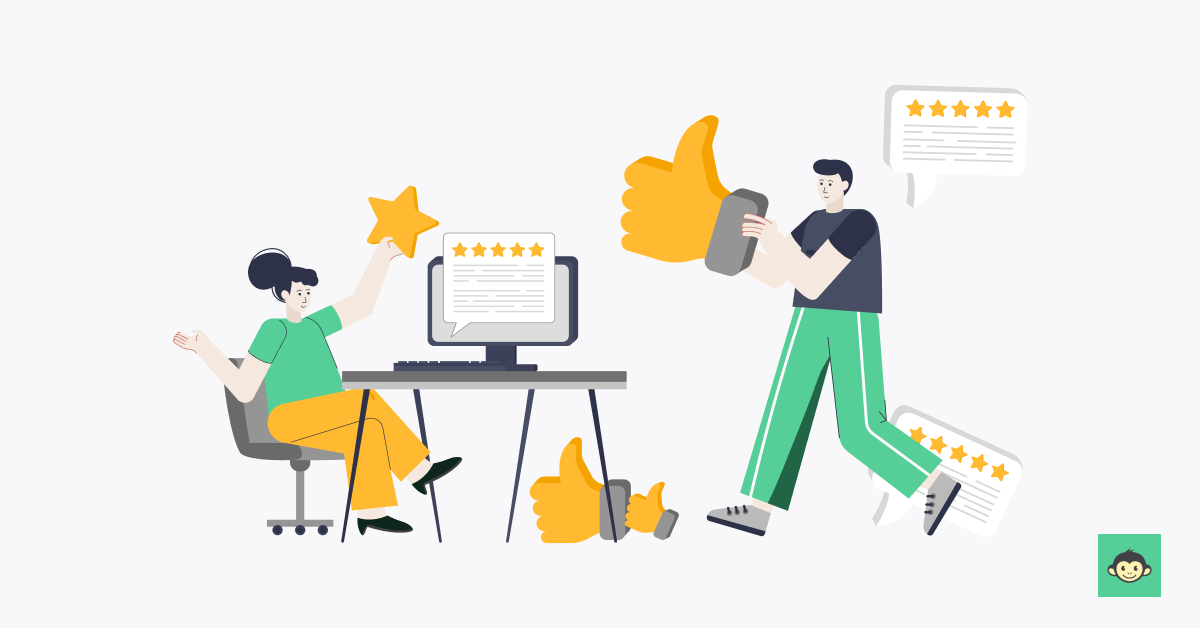New employee orientation: Checklist and significance of onboarding surveys in 2024

The way we welcome new team members has evolved into a dynamic and strategic process. Employee orientation is no longer just about the first-day formalities; it's a comprehensive experience that sets the stage for a fulfilling and lasting professional journey.
Join us as we unravel the secrets of effective onboarding, exploring a checklist that embraces the latest trends, best practices that foster engagement, and the crucial role of onboarding surveys in shaping a seamless integration into the workforce.
Get ready to navigate the landscape of new employee orientation with confidence and innovation!
What is new employee orientation?

New employee orientation, often referred to as onboarding, is the crucial process by which organizations welcome and integrate fresh talent into their workforce. It's more than just a series of paperwork and office tour; it's the initial introduction to the company culture, values, and expectations.
Think of it as the compass that guides new hires through the labyrinth of their new professional environment.
In essence, new employee orientation is the company's way of ensuring that every newcomer feels not only informed about their role and responsibilities but also connected to the broader organizational fabric.
It's the pivotal moment when a simple job offer transforms into a meaningful and productive relationship between the employee and the company. In the evolving landscape of 2024, new employee orientation has become a strategic initiative, aligning the individual with the company's mission and vision from day one.
Onboarding vs orientation
Understanding the distinction between onboarding and orientation is crucial for companies aiming to integrate new employees effectively and ensure long-term success. While both processes play significant roles in acclimating new hires to the organization, they serve distinct purposes and involve different activities.
Definition and Scope
Orientation: Orientation is typically a one-time event that occurs on the first day or within the first week of employment. It focuses on introducing new employees to the company, its policies, and its culture. The primary goal is to provide essential information that helps new hires understand the basics of the organization and their roles.
Onboarding: Onboarding, on the other hand, is an extended process that can last from several weeks to several months. It encompasses all the activities that help new employees acclimate to their new roles and integrate into the company. This process is designed to enhance engagement, build relationships, and ensure that new hires are fully productive.
Objectives
Orientation:
- Acquaint new employees with the company's mission, vision, and values.
- Provide an overview of company policies, procedures, and benefits.
- Introduce key personnel and departments.
- Ensure completion of necessary paperwork and compliance training.
Onboarding:
- Facilitate a deeper understanding of job responsibilities and expectations.
- Promote integration into the company culture and team dynamics.
- Provide ongoing training and development opportunities.
- Foster continuous feedback and communication between new hires and their managers.
Duration
- Orientation: Generally lasts a few hours to a couple of days. It is a concentrated session meant to equip new hires with fundamental information quickly.
- Onboarding: Extends over a period of time, often 90 days to a year, allowing for gradual assimilation and continuous support.
Activities Involved
Orientation:
- Formal presentations on company history and structure.
- Distribution of employee handbooks.
- Tours of the workplace.
- Initial introductions to team members.
Onboarding:
- Regular check-ins and one-on-one meetings with supervisors.
- Mentorship and buddy programs.
- In-depth training sessions and workshops.
- Participation in team-building activities and company events.
Impact on Employee Experience
- Orientation: Sets the stage for the employee's initial perception of the company. It ensures that new hires feel welcomed and informed, reducing first-day anxieties.
- Onboarding: Significantly influences long-term job satisfaction, performance, and retention. A comprehensive onboarding program helps employees feel more connected, competent, and committed to the organization.
Purpose of new employee orientation in the workplace
Onboarding and orientation programs serve as vital components in ensuring a seamless transition for new employees into an organization. They are designed to not only welcome new hires but to also strategically equip them for success within the company. Below are key purposes of these programs:
- Clarification of expectations: Onboarding and orientation provide clarity on job roles, responsibilities, and performance expectations. By understanding what is expected from the outset, new employees can align their efforts with organizational goals, reducing confusion and enhancing productivity.
- Facilitation of organizational understanding: These programs offer a comprehensive overview of the company’s structure, hierarchy, and key stakeholders. New hires gain insight into how their role fits within the larger organizational framework, which is crucial for effective collaboration and communication.
- Promotion of ethical standards and compliance: Onboarding serves as a critical opportunity to introduce new employees to the company’s code of conduct, ethical guidelines, and compliance requirements. This ensures that employees are aware of and adhere to the legal and ethical standards of the organization from day one.
- Reduction of initial anxiety: The first days in a new job can be stressful. Onboarding programs are designed to alleviate this anxiety by providing new hires with the information, resources, and support they need to feel confident in their new roles.
- Cultivation of long-term relationships: These programs foster early relationships between new employees, their peers, and supervisors. Establishing these connections early on encourages a sense of belonging and facilitates ongoing collaboration.
New employee orientation benefits

The benefits of a well-orchestrated and effective new hire orientation and employee orientation extend far beyond a warm welcome and a desk assignment.
In the intricate dance of onboarding, companies discover a multitude of advantages that not only enhance the employee experience but also contribute to organizational success.
Boosted retention rates
Effective orientation isn't just a nicety; it's a retention powerhouse. Statistics reveal that companies with structured onboarding programs witness a 50% higher retention rate among their new hires. By creating a positive first impression, organizations lay the groundwork for long-term commitment.
Accelerated time-to-productivity
Picture this: a new employee hitting the ground running from day one. That's the magic of a robust orientation process. It doesn't just acquaint hires with company policies; it empowers them with the knowledge and tools needed to be productive swiftly, minimizing the infamous "ramp-up" time.
Enhanced employee engagement
Orientation goes beyond handing out employee handbooks; it's about instilling a sense of belonging. Engaged employees are 87% less likely to leave their jobs, emphasizing the critical role of orientation in fostering a connection to the company culture and values.
Improved job satisfaction
Happy employees make for a happy workplace. A well-crafted orientation ensures that new hires not only understand their roles but also feel confident and supported in their positions. The result? Increased job satisfaction, translating into a more positive and motivated workforce.
Strengthened team dynamics
Orientation isn't a solo act; it's a team effort. By incorporating team-building activities and fostering camaraderie from day one, companies create a collaborative environment and effective team dynamics. Studies show that employees who feel connected to their colleagues are more likely to stay with the organization.
Enhanced employer brand
In the era of social media and Glassdoor reviews, a positive onboarding experience becomes part of your employer brand. Word spreads quickly about companies that invest in their employees. A stellar orientation program can attract top talent and positively influence your organization's reputation.
Increased adaptability
A comprehensive orientation program equips new employees with a thorough understanding of the company's operations, goals, and culture. This knowledge enables them to adapt more quickly to changes and challenges within the organization, fostering a resilient and agile workforce.
Reduced onboarding costs
Investing in a structured orientation process can lead to significant cost savings in the long run. By reducing turnover rates and improving employee productivity, companies can lower the expenses associated with recruiting, hiring, and training new staff members.
Increased compliance and risk management
A well-structured orientation program ensures that new employees are fully aware of legal and regulatory requirements specific to their roles and the organization. This not only mitigates risks associated with non-compliance but also fosters a culture of accountability and transparency, ultimately safeguarding the company's interests.
Heightened innovation and creativity
When new employees are thoroughly oriented, they gain a comprehensive understanding of the company’s mission, vision, and goals. This foundational knowledge encourages them to contribute fresh ideas and innovative solutions early on, driving the organization towards continuous improvement and competitive advantage.
New employee orientation objectives

Embarking on the journey of starting a new job, employee orientation involves a set of clear objectives that go beyond merely introducing someone to their workstation. In the dynamic landscape of 2024, these objectives serve as the guiding principles for a successful onboarding experience:
Cultural assimilation
Objective: Immerse new hires in the company culture and values.
Orientation isn't just about policies; it's about weaving newcomers into the cultural fabric. By familiarizing them with the company's mission, vision, and core values, organizations create a shared sense of purpose.
Role clarity
Objective: Ensure a comprehensive understanding of job roles and responsibilities.
The first days shouldn't be a guessing game. Clear communication about expectations and job functions ensures that new employees feel equipped and empowered in their roles from the outset.
Integration with teams:
Objective: Foster connections with colleagues and team members.
Successful onboarding extends beyond the individual. It's about creating a sense of belonging by facilitating introductions, team-building activities, and providing opportunities for collaboration.
Introduction to organizational policies:
Objective: Communicate essential company policies and procedures.
Orientation serves as the playbook, introducing new hires to the rules of the game. From HR policies to workplace etiquette, ensuring awareness and compliance is crucial for a smooth integration.
Technology and tools familiarization:
Objective: Equip new employees with the necessary tools and technology.
In the digital age, orientation isn't just about physical spaces. It involves providing access and training on the technologies and tools essential for effective job performance.
Engagement and motivation
Objective: Create an environment that instills motivation and engagement.
Orientation sets the tone for the employee experience. By incorporating motivational elements, companies can inspire commitment and enthusiasm, leading to a more engaged workforce.
Feedback and continuous improvement:
Objective: Establish channels for feedback and improvement.
The orientation process isn't static; it's a continuous loop of improvement. Creating avenues for feedback ensures that organizations can adapt and enhance their onboarding strategies over time.
Legal compliance:
Objective: Ensure new hires are aware of and adhere to legal requirements.
Beyond the company's internal policies, orientation includes an overview of legal obligations. This ensures that employees are well-informed and compliant with regulations from the outset.
In the tapestry of new employee orientation objectives, each thread contributes to a seamless integration process that not only equips individuals for their roles but also aligns them with the broader goals and values of the organization.
What should be included in a new employee orientation process?

Crafting an effective new employee orientation process involves more than just ticking off items on a checklist. In the ever-evolving landscape of 2024, the onboarding journey is a carefully curated experience that goes beyond paperwork and office tours.
Here's a glimpse into what should be included to ensure your new hires are not just welcomed but seamlessly integrated into the fabric of your organization:
Digital onboarding platforms
Leverage technology to streamline the paperwork process and create a user-friendly onboarding experience. Digital platforms not only reduce administrative hassles but also set the stage for a tech-savvy work environment.
Interactive welcome sessions
Move beyond monotone presentations. Conduct engaging welcome sessions that introduce new hires to the company culture, values, and key organizational contacts. This sets the tone for a personalized and inclusive onboarding journey.
Team-building activities
Break the ice early on. Incorporate team-building exercises to foster connections among new hires and existing team members. Whether in-person or virtual, these activities contribute to a sense of camaraderie.
Comprehensive job training
Provide detailed training on new job, roles and responsibilities. This ensures that new employees not only understand their individual contributions but also feel confident in their ability to excel in their positions.
Introduction to company policies
Navigate through the intricacies of company policies and procedures. From HR guidelines to workplace ethics, clarity on these policies is essential for a smooth and compliant onboarding process.
Personalized onboarding plans
Recognize that one size doesn't fit all. Tailor onboarding plans to suit the individual needs and roles of new hires. This personal touch contributes to a more meaningful and effective onboarding experience.
Buddy system implementation
Embrace the power of a buddy system. Pair new hires with experienced colleagues who can guide them through the nuances of the organization, providing valuable insights and fostering a supportive atmosphere.
Introduction to company culture
Go beyond mission statements. Immerse new hires in the day-to-day nuances of the company culture. This includes understanding communication styles, collaboration norms, and the overall vibe of the workplace.
Regular check-ins
Make onboarding an ongoing conversation. Regular check-ins with new employees allow for feedback, addressing concerns, and ensuring that the onboarding journey remains a positive and evolving experience.
Accessibility to resources
Ensure that new hires have easy access to essential resources. This includes not only physical tools but also avenues for seeking guidance, asking questions, and accessing support throughout the onboarding process.
What is a new employee orientation program?

A new employee orientation program transcends the traditional onboarding process, evolving into a well-designed strategy that orchestrates a comprehensive introduction to the company's culture, values, and operational intricacies.
In the realm of 2024, a full new hire and employee orientation program is akin to a customized roadmap, ensuring that each newcomer doesn't just join the team but becomes an integral part of the organizational journey.
Here are some key components of a new employee orientation program:
- Strategic onboarding timeline: A proper orientation program extends beyond the first day. It encompasses a structured timeline, guiding new hires through a series of events, training sessions, and interactions over the initial weeks or months, ensuring a gradual and effective assimilation.
- Multi-channel introduction: Embrace diversity in communication. A program incorporates various channels, from in-person sessions to digital resources, ensuring that information is disseminated in a way that suits different learning styles and preferences.
- Personalized learning paths: Recognize the individuality of each new hire. A program tailors learning paths based on roles, ensuring that employees receive training and information relevant to their specific positions and responsibilities.
- Integration of technology: Step into the digital age. A program leverages technology for efficient onboarding, utilizing digital platforms for paperwork, training modules, and interactive sessions that reflect the tech-savvy nature of modern workplaces.
- Team-building elements: It's not just about solitary onboarding. A program integrates team-building activities, fostering connections among new hires and existing team members. This inclusionary approach contributes to a sense of belonging.
- Continuous feedback mechanism: Feedback is a two-way street. A program establishes a continuous feedback loop, allowing new hires to express concerns, ask questions, and provide insights. This iterative process contributes to ongoing program enhancement.
- Mentorship and support structures: Recognize the power of guidance. A program incorporates mentorship initiatives, pairing new hires with experienced colleagues who can provide insights, answer questions, and offer support throughout the onboarding journey.
- Measurement of success metrics: A program doesn't end; it evolves. Success is measured through key performance indicators, employee satisfaction surveys, and retention rates, allowing organizations to continually refine and improve their onboarding strategies.
- Cultural immersion activities: Deepen the understanding of company culture. A program includes activities and sessions designed to immerse new employees in the company's history, mission, and values, ensuring they feel connected to the larger organizational purpose.
- Opportunities for skill development: Foster growth from the start. A program offers new hires opportunities for professional development, such as workshops, courses, and certifications, aligning their growth with the company's strategic objectives.
- Cross-departmental exposure: Encourage a holistic understanding of the company. A program provides new hires with opportunities to interact with various departments, allowing them to gain insights into different functions and how their role contributes to the overall business objectives. This cross-functional exposure fosters collaboration and a more comprehensive grasp of the organizational structure.
- Employee wellness orientation: Prioritize well-being from day one. A program includes an introduction to the company’s wellness initiatives, such as mental health resources, fitness programs, and work-life balance policies. This focus on wellness underscores the organization’s commitment to supporting employees both personally and professionally.
New employee orientation checklist to follow in 2024

Crafting a comprehensive new employee orientation checklist goes beyond the traditional to ensure a seamless and engaging onboarding experience. This checklist serves as a strategic guide for organizations, encompassing essential elements tailored to the evolving needs of the modern workplace:
- Digital onboarding platforms integration: Leverage technology for a paperless onboarding process, utilizing digital platforms to streamline paperwork and enhance efficiency.
- Virtual welcome sessions: Embrace virtual platforms for engaging welcome sessions that introduce new hires to the company's culture, values, and key contacts.
- Personalized orientation plans: Tailor employee orientation ideas and plans to individual roles, ensuring that each new employee receives training and information relevant to their specific responsibilities.
- Technology familiarization: Include sessions on the usage of digital tools, software, and platforms relevant to the new employee's role, promoting tech-savviness.
- Interactive team-building activities: Foster connections among new hires and existing team members through virtual or in-person team-building activities that enhance camaraderie.
- Regular check-ins and feedback sessions: Establish a framework for regular check-ins and feedback sessions, providing opportunities for new hires to express concerns and ask questions.
- Assigned mentorship: Implement a mentorship program pairing new hires with experienced colleagues who can offer guidance, insights, and support throughout the onboarding journey.
- Accessibility to resources: Ensure new hires have easy access to essential resources, both physical and digital, to facilitate a smooth transition into their roles. If you provide laptops to new hires, make sure to remove the files of previous employees. If using a Mac, you can perform a factory reset by following these guidelines.
- Introduction to remote work dynamics: If applicable, provide insights into the dynamics of remote work, including virtual collaboration tools and best practices for a productive remote work environment.
- Employee well-being initiatives: Incorporate initiatives focused on employee well-being, addressing aspects such as employee stress management and work-life balance, promoting a holistic approach to onboarding.
What to avoid in an employee orientation?
A well-structured employee orientation is crucial for setting the right tone and laying the foundation for a successful tenure. However, certain pitfalls can undermine its effectiveness. Here are key aspects to avoid during an employee orientation:
Overloading with information
- Avoid information dumping: Bombarding new hires with excessive information on the first day can be overwhelming and counterproductive. It's important to prioritize essential information and spread out the learning process over time.
- Solution: Break down the orientation into manageable segments, focusing on critical topics initially and scheduling follow-up sessions for more detailed discussions.
Lack of engagement
- Avoid monotonous presentations: Long, lecture-style presentations without interaction can lead to disengagement. New employees may struggle to retain information if they are not actively involved.
- Solution: Incorporate interactive elements such as group discussions, Q&A sessions, and hands-on activities to keep new hires engaged and participative.
Neglecting cultural integration
- Avoid ignoring company culture: Failing to introduce new hires to the company culture and values can hinder their ability to integrate fully. Understanding the organizational culture is crucial for alignment and satisfaction.
- Solution: Include sessions that highlight the company's mission, vision, values, and cultural norms. Use storytelling and examples to illustrate these concepts effectively.
Inadequate preparation
- Avoid last-minute arrangements: An unorganized orientation session reflects poorly on the company and can leave new hires feeling undervalued. Lack of preparation can lead to logistical issues and confusion.
- Solution: Plan the orientation thoroughly, ensuring all materials, schedules, and resources are prepared in advance. Assign specific roles and responsibilities to team members involved in the process.
Ignoring feedback
- Avoid one-way communication: An orientation that doesn't solicit feedback from new hires misses an opportunity for improvement. New employees may have valuable insights on how to enhance the process.
- Solution: Implement a feedback mechanism, such as surveys or feedback forms, to gather input from new hires. Use this feedback to make continuous improvements to the orientation program.
Failure to personalize
- Avoid one-size-fits-all approach: Treating all new hires the same can overlook individual needs and roles. Different departments and positions may require tailored information and training.
- Solution: Customize the orientation process to address the specific requirements of different roles and departments. Provide relevant information and training that align with their job responsibilities.
Neglecting follow-up
- Avoid a one-and-done approach: Viewing orientation as a single event rather than the start of an ongoing process can lead to gaps in support and development.
- Solution: Establish a follow-up plan that includes regular check-ins, additional training sessions, and continuous support to ensure new hires are settling in well and progressing in their roles.
New hire orientation icebreakers
New hire orientation icebreakers are essential tools for creating a welcoming atmosphere and fostering connections among new employees. These activities are strategically designed to ease the initial discomfort and encourage meaningful interaction. Here are eight effective icebreakers that can be utilized during orientation:
Two truths and a lie
This classic icebreaker invites each participant to share two true statements and one false statement about themselves. The group then guesses which statement is the lie. This activity not only sparks conversation but also helps team members learn interesting facts about each other in a fun, engaging way.
Personal timeline
New hires create a brief timeline of significant events in their lives, both professional and personal, and share it with the group. This exercise helps participants to reflect on their journey and provides context for their experiences and motivations, fostering deeper understanding among team members.
Common ground
In this activity, participants are grouped together and challenged to discover as many things they have in common as possible within a set time. This icebreaker encourages collaboration and helps new hires quickly find shared interests, which can lead to stronger workplace relationships.
Team bingo
Each participant receives a bingo card filled with various statements or characteristics (e.g., "Has traveled to more than five countries" or "Plays a musical instrument"). Employees then mingle to find colleagues who match the statements, marking off squares as they go. This activity is a dynamic way to encourage networking and uncover hidden talents within the group.
Role reversal
New hires pair up and interview each other about their backgrounds and aspirations, then introduce their partner to the group. This exercise not only breaks the ice but also helps employees practice active listening and communication skills, laying the foundation for effective teamwork.
Desk item show-and-tell
Ask new hires to select an item from their desk or workspace that holds personal significance and share its story with the group. This simple activity helps employees express their individuality and provides insight into their personal interests and values, fostering a more personal connection among team members.
Themed speed networking
Organize a series of brief, one-on-one interactions where new hires discuss specific themes or questions, such as "What motivated you to join this company?" or "What skill are you most excited to develop here?" This structured approach to networking allows new employees to quickly get acquainted with multiple colleagues while discussing topics that build rapport and professional alignment.
Creative name tags
Encourage new hires to design their own name tags with creative elements that represent their hobbies, personality traits, or professional skills. Afterward, each employee explains the significance of their design to the group. This activity adds a personal touch to introductions and allows colleagues to connect on a more meaningful level beyond just names and job titles.
7 New employee orientation activities to try at work

Step into the future of onboarding with these seven engaging activities designed to transform the traditional new employee orientation into an interactive and memorable experience:
- Virtual scavenger hunt: Kick off onboarding with a fun and interactive virtual scavenger hunt. This activity encourages new hires to explore digital spaces, fostering a sense of excitement and engagement.
- Welcome video messages: Personalize the onboarding experience with welcome video messages from team members and leadership. This adds a human touch, making new employees feel connected and valued from the start.
- Interactive workshops or webinars: Conduct interactive workshops or webinars covering key aspects of the company culture, values, and essential skills. This allows for active participation and knowledge absorption beyond traditional presentations.
- Team introduction bingo: Turn introductions into a game with Team Introduction Bingo. New hires can interact with colleagues to fill out their bingo cards, creating connections while learning more about their teammates.
- Digital employee handbook scavenger hunt: Transform the mundane task of reading the employee handbook into an engaging activity. Create a digital scavenger hunt within the handbook, prompting new hires to find and understand key policies and information.
- Mentorship meet-and-greet: Arrange a meet-and-greet session where new hires can connect with their assigned mentors. This activity helps establish a support system from day one and provides a go-to person for any questions or guidance.
- Office trivia challenge: Organize an office trivia challenge that covers fun facts about the company, its history, and its employees. This lighthearted competition encourages team bonding and helps new hires learn interesting tidbits about their new workplace.
10 New employee orientation best practices to follow in the onboarding process

- Holistic integration with HR: Ensure seamless collaboration between different departments, particularly with Human Resources, to align onboarding processes with broader organizational strategies.
- Clear communication of expectations: Communicate clear expectations from the outset, helping new hires understand their roles, responsibilities, and performance expectations.
- Encourage networking opportunities: Facilitate networking opportunities for new hires within the organization, promoting connections beyond their immediate teams and enhancing the sense of community.
- Continuous learning opportunities: Foster a culture of continuous learning by providing ongoing training opportunities, workshops, and resources to support professional development.
- Adaptability to remote work dynamics: If applicable, design onboarding processes that account for remote work dynamics, ensuring new hires feel connected and supported in virtual environments.
- Interactive welcome kit: Create an interactive welcome kit that includes not only essential documents but also engaging materials that reflect the company's culture and values.
- Structured cross-departmental exposure: Facilitate exposure to various departments within the organization, offering insights into different functions and encouraging cross-departmental collaboration.
- Recognition of milestones: Celebrate onboarding milestones, whether it's the completion of training modules or the successful completion of the probationary period, to acknowledge achievements.
- Open channels for employee feedback: Establish open channels for feedback, allowing new hires to provide insights into their onboarding experience, fostering a culture of continuous improvement.
- Emphasis on inclusivity and diversity: Prioritize inclusivity and diversity in the onboarding process, ensuring that all new hires feel welcome and valued regardless of their background or identity.
Significance of employee onboarding surveys in the onboarding process

Employee onboarding surveys play a pivotal role in the enhancement and evolution of the onboarding process.
By providing continuous improvement insights, measuring engagement, identifying pain points, and allowing for customization based on individual needs, these surveys contribute to a positive and aligned onboarding experience.
Their impact extends to enhancing retention strategies, aligning with company values, positively influencing employee satisfaction, and facilitating data-driven decision-making.
Ultimately, onboarding surveys foster transparent communication, strengthening the connection between the organization and new hires and strategically aligning the onboarding and hiring process with broader organizational goals.
Why do you need employee lifecycle management software to reduce early attrition at work?

Employee lifecycle management software is a strategic tool to combat early attrition by offering comprehensive data analytics, enabling proactive risk identification, streamlining onboarding processes, and providing continuous monitoring and feedback.
The software supports personalized development plans, strategic succession planning, and enhanced communication, fostering a positive work environment. It integrates features for continuous learning, transparent performance management, and adaptability to remote work dynamics.
This holistic approach ensures organizations are equipped to address the root causes of early attrition and implement targeted retention strategies tailored to individual needs.
Conclusion
From engaging activities to strategic software solutions, every aspect contributes to reducing early attrition and fostering a thriving workplace.
As you embark on the journey of enhancing your onboarding experience, consider partnering with CultureMonkey for a seamless and culture-driven onboarding process. Elevate your onboarding game and set the stage for lasting success. Explore CultureMonkey today!
FAQs
1. What is new employee orientation?
New employee orientation is a structured process designed to introduce new hires to the company's culture, policies, and expectations. It helps employees understand their roles, meet their colleagues, and learn about the organization's mission and values. The goal is to ensure new employees feel welcomed, informed, and prepared to start their job effectively, fostering a sense of belonging from the very beginning.
2. How long is orientation?
Orientation typically lasts from a few hours to a few days, depending on the company's size and complexity. Some organizations extend the process over several weeks to ensure comprehensive integration. The duration can vary, but the aim is to provide new employees with sufficient time to absorb essential information, complete necessary paperwork, and start feeling comfortable in their new work environment.
3. Why orientation is important for new employees?
Orientation is crucial for new employees as it sets the foundation for their future success within the company. It helps them understand the company's culture, expectations, and their specific roles, which reduces anxiety and boosts confidence. A well-structured orientation fosters engagement, improves job satisfaction, and increases retention rates, ensuring that new hires feel valued and part of the team from day one.
4. What are some tips for a virtual orientation?
For a successful virtual orientation, ensure technology is reliable and user-friendly. Use interactive tools like video conferencing, virtual tours, and digital handbooks. Schedule regular check-ins and Q&A sessions to maintain engagement. Encourage team introductions and networking through virtual icebreakers. Providing clear instructions and support throughout the process will help new employees feel connected and informed, even in a remote setting.
5. What topics are typically covered during orientation?
Orientation typically covers topics such as company history, mission, and values; organizational structure; key policies and procedures; benefits and compensation; workplace safety; and an overview of the new employee's specific role and responsibilities. Additionally, it includes introductions to team members and departments, as well as training on any necessary tools or software.
6. Who will conduct the orientation?
Orientation is usually conducted by a combination of human resources professionals, department managers, and direct supervisors. HR typically covers general company policies and benefits, while managers and supervisors provide role-specific information and training. In some cases, experienced team members or mentors may also participate to help new employees acclimate and feel welcomed.



